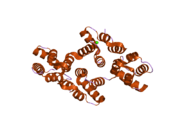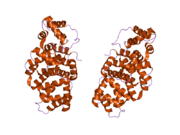ANXA8L2
Annexin A8-like protein 2 is a protein that in humans is encoded by the ANXA8L2 gene.[5]
This gene encodes a member of the annexin family of evolutionarily conserved Ca2+ and phospholipid binding proteins. The encoded protein may function as an anticoagulant that indirectly inhibits the thromboplastin-specific complex. Overexpression of this gene has been associated with acute myelocytic leukemia. A highly similar duplicated copy of this gene is found in close proximity on the long arm of chromosome 10.[5]
References
External links
- Human ANXA8 genome location and ANXA8 gene details page in the UCSC Genome Browser.
- Human ANXA8L1 genome location and ANXA8L1 gene details page in the UCSC Genome Browser.
Further reading
- Gerke V, Moss SE (2002). "Annexins: from structure to function". Physiol. Rev. 82 (2): 331–71. doi:10.1152/physrev.00030.2001. PMID 11917092.
- Gerke V, Creutz CE, Moss SE (2005). "Annexins: linking Ca2+ signalling to membrane dynamics". Nat. Rev. Mol. Cell Biol. 6 (6): 449–61. doi:10.1038/nrm1661. PMID 15928709.
- Chang KS, Wang G, Freireich EJ, et al. (1992). "Specific expression of the annexin VIII gene in acute promyelocytic leukemia". Blood. 79 (7): 1802–10. PMID 1313714.
- Chambers JA, Gardner E, Hauptmann R, et al. (1993). "TaqI polymorphisms at the annexin VIII locus (ANX8)". Hum. Mol. Genet. 1 (7): 550. doi:10.1093/hmg/1.7.550. PMID 1364010.
- Hauptmann R, Maurer-Fogy I, Krystek E, et al. (1989). "Vascular anticoagulant beta: a novel human Ca2+/phospholipid binding protein that inhibits coagulation and phospholipase A2 activity. Its molecular cloning, expression and comparison with VAC-alpha". Eur. J. Biochem. 185 (1): 63–71. doi:10.1111/j.1432-1033.1989.tb15082.x. PMID 2530088.
- Sarkar A, Yang P, Fan YH, et al. (1994). "Regulation of the expression of annexin VIII in acute promyelocytic leukemia". Blood. 84 (1): 279–86. PMID 8018923.
- Reutelingsperger CP, van Heerde W, Hauptmann R, et al. (1994). "Differential tissue expression of Annexin VIII in human". FEBS Lett. 349 (1): 120–4. doi:10.1016/0014-5793(94)00559-1. PMID 8045287.
- Maruyama K, Sugano S (1994). "Oligo-capping: a simple method to replace the cap structure of eukaryotic mRNAs with oligoribonucleotides". Gene. 138 (1–2): 171–4. doi:10.1016/0378-1119(94)90802-8. PMID 8125298.
- Suzuki Y, Yoshitomo-Nakagawa K, Maruyama K, et al. (1997). "Construction and characterization of a full length-enriched and a 5'-end-enriched cDNA library". Gene. 200 (1–2): 149–56. doi:10.1016/S0378-1119(97)00411-3. PMID 9373149.
- Strausberg RL, Feingold EA, Grouse LH, et al. (2003). "Generation and initial analysis of more than 15,000 full-length human and mouse cDNA sequences". Proc. Natl. Acad. Sci. U.S.A. 99 (26): 16899–903. doi:10.1073/pnas.242603899. PMC 139241. PMID 12477932.
- Ota T, Suzuki Y, Nishikawa T, et al. (2004). "Complete sequencing and characterization of 21,243 full-length human cDNAs". Nat. Genet. 36 (1): 40–5. doi:10.1038/ng1285. PMID 14702039.
- Deloukas P, Earthrowl ME, Grafham DV, et al. (2004). "The DNA sequence and comparative analysis of human chromosome 10". Nature. 429 (6990): 375–81. doi:10.1038/nature02462. PMID 15164054.
- Gerhard DS, Wagner L, Feingold EA, et al. (2004). "The status, quality, and expansion of the NIH full-length cDNA project: the Mammalian Gene Collection (MGC)". Genome Res. 14 (10B): 2121–7. doi:10.1101/gr.2596504. PMC 528928. PMID 15489334.
- Stein T, Price KN, Morris JS, et al. (2006). "Annexin A8 is up-regulated during mouse mammary gland involution and predicts poor survival in breast cancer". Clin. Cancer Res. 11 (19 Pt 1): 6872–9. doi:10.1158/1078-0432.CCR-05-0547. PMID 16203777.
- Kimura K, Wakamatsu A, Suzuki Y, et al. (2006). "Diversification of transcriptional modulation: large-scale identification and characterization of putative alternative promoters of human genes". Genome Res. 16 (1): 55–65. doi:10.1101/gr.4039406. PMC 1356129. PMID 16344560.
- Goebeler V, Ruhe D, Gerke V, Rescher U (2006). "Annexin A8 displays unique phospholipid and F-actin binding properties". FEBS Lett. 580 (10): 2430–4. doi:10.1016/j.febslet.2006.03.076. PMID 16638567.
This article is issued from
Wikipedia.
The text is licensed under Creative Commons - Attribution - Sharealike.
Additional terms may apply for the media files.





